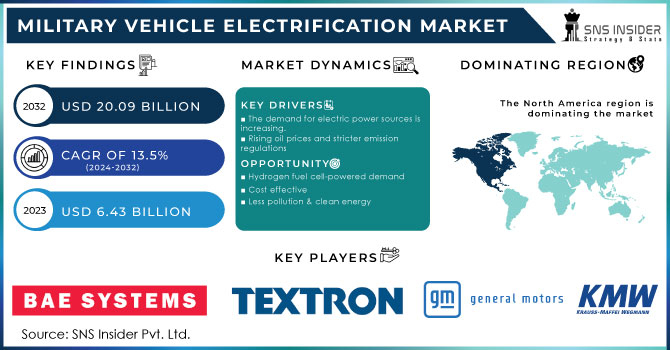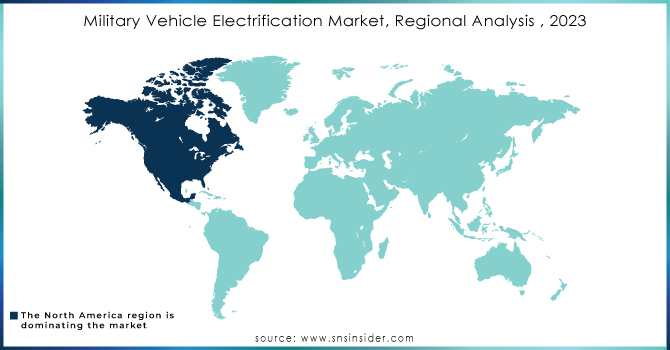Military Vehicle Electrification Market Report Scope & Overview:

To get more information on Military Vehicle Electrification Market - Request Free Sample Report
The Military Vehicle Electrification Market Size was valued at USD 6.43 billion in 2023 and is expected to reach USD 20.09 billion by 2032 and grow at a CAGR of 13.5% over the forecast period 2024-2032.
A tactical vehicle with hybrid-electric capabilities and in-hub electric drive is the military vehicle electrification. The research and development in military vehicle electrification are constantly evolving, and the current scenario of countries cutting their defense budgets may be a hindrance to the growth of this technology. Because of import and export regulations, manufacturing activities have faced operational and running challenges.
MARKET DYNAMICS
KEY DRIVERS
-
The demand for electric power sources is increasing.
-
Rising oil prices and stricter emission regulations
-
Increasing demand for self-driving military vehicles
RESTRAINTS
-
Short range of electric vehicle
-
Limited Advantages
OPPORTUNITIES
-
Hydrogen fuel cell-powered demand
-
Cost effective
-
Less pollution & clean energy
CHALLENGES
-
Limited charging capability
-
Even replacing a battery pack is prohibitively expensive.
THE IMPACT OF COVID-19
COVID-19 started in Wuhan in December 2019 and has since spread rapidly around the world. The US, India, Brazil, Russia, France, the UK, Turkey, Italy, and Spain are some of the countries most affected in terms of confirmed cases and reported deaths. COVID-19 has been affecting the economy and industry in various countries due to land closures, travel restrictions, and business closures. The closure of various plants and factories has affected the global supply chain and has had a devastating effect on the manufacturing, delivery, and marketing of products in global markets.
Few companies have already announced potential product delivery delays and sales declines in the future. In addition, international travel restrictions imposed on European, Asian-Pacific, and North American countries affect business cooperation and relationship opportunities.
MARKET ESTIMATION
Growth in the market for electric vehicle fittings is predicted to promote equitable growth in three phases. The need for the electrical installation of military vehicles in combat and support vehicles is predicted to be relatively relative during the forecast period. The power generation component is expected to grow at the fastest CAGR at the time of forecasting, based on plans. The market for military vehicle electrification is expected to grow due to increased demand for energy systems due to the integration of new technologies and increased energy needs in vehicles.
The proportion of private or private military vehicles is expected to grow at the fastest CAGR at the time of forecasting, based on performance. The proportion of private or private military vehicles is expected to grow at the fastest CAGR at the time of forecasting, based on performance. The need for private vehicles that help reduce human losses and skills development fuels the growing market for private or private military vehicles. The market for North American military vehicles is expected to grow significantly during the forecast period, due to increased investment in international military vehicle technology. European defense services have contributed to the development of technologically advanced military vehicles and the acquisition of new vehicles to increase the size of their ships. Vehicle electrification systems from well-known and well-known manufacturers.
COMPETITIVE LANDSCAPE
The report discusses major developments in the military vehicle electrification market, as well as organic and inorganic growth strategies. Various business sectors are focusing on natural and chemical-free growth strategies such as product launches, product approvals, and other things like patents and events. Acquisitions, partnerships, and collaborations were among the inorganic growth strategies observed in the market.
KEY MARKET SEGMENTATION
By Operation
-
Manned
-
Autonomous
-
Semi-autonomous
By Technology
-
Hybrid
-
Fully Electric
By System
-
Power Generation
-
Cooling System
-
Energy Storage
-
Traction Drive System
-
Power Conversion
By Platform
-
Combat vehicles
-
Support vehicles
-
Unmanned armoured vehicles
REGIONAL ANALYSIS
Due to rising expenditures in military vehicle electrification technologies by countries in this region, the North American military vehicle electrification market is expected to grow significantly over the forecast period. European defense ministries are working to develop technologically superior military vehicles while also acquiring new vehicles to add to their inventory. During the forecast period, the Asia Pacific military vehicle electrification market is expected to grow at the fastest rate. The Asia Pacific military vehicle electrification market is expanding as major economies in the region increase their military vehicle procurement spending.

Need any customization research on Military Vehicle Electrification Market - Enquiry Now
REGIONAL COVERAGE:
-
North America
-
USA
-
Canada
-
Mexico
-
-
Europe
-
Germany
-
UK
-
France
-
Italy
-
Spain
-
The Netherlands
-
Rest of Europe
-
-
Asia-Pacific
-
Japan
-
south Korea
-
China
-
India
-
Australia
-
Rest of Asia-Pacific
-
-
The Middle East & Africa
-
Israel
-
UAE
-
South Africa
-
Rest of Middle East & Africa
-
-
Latin America
-
Brazil
-
Argentina
-
Rest of Latin America
-
KEY PLAYERS
The Major Players are BAE Systems plc, Krauss-Maffei Wegmann GmbH, Textron Inc, General Motors Company, Nikola Corporation, Qinetiq Group Plc, General Dynamics Corporation, Arquus, Nexter group, Leonardo S.p.A., and other players.
| Report Attributes | Details |
|---|---|
| Market Size in 2023 | US$ 6.43 Billion |
| Market Size by 2032 | US$ 20.09 Billion |
| CAGR | CAGR of 13.5% From 2024 to 2032 |
| Base Year | 2023 |
| Forecast Period | 2024-2032 |
| Historical Data | 2020-2022 |
| Report Scope & Coverage | Market Size, Segments Analysis, Competitive Landscape, Regional Analysis, DROC & SWOT Analysis, Forecast Outlook |
| Key Segments | • By System (Power Generation, Cooling System, Energy Storage, Traction Drive System and Power Conversion) • By Technology (Hybrid and Fully Electric) • By Platform • By Operation |
| Regional Analysis/Coverage | North America (USA, Canada, Mexico), Europe (Germany, UK, France, Italy, Spain, Netherlands, Rest of Europe), Asia-Pacific (Japan, South Korea, China, India, Australia, Rest of Asia-Pacific), The Middle East & Africa (Israel, UAE, South Africa, Rest of Middle East & Africa), Latin America (Brazil, Argentina, Rest of Latin America) |
| Company Profiles | BAE Systems plc, Krauss-Maffei Wegmann GmbH, Textron Inc, General Motors Company, Nikola Corporation, Qinetiq Group Plc, General Dynamics Corporation, Arquus, Nexter group, Leonardo S.p.A., and other players. |
| DRIVERS | • The demand for electric power sources is increasing. • Rising oil prices and stricter emission regulations • Increasing demand for self-driving military vehicles |
| RESTRAINTS | • Short range of electric vehicle • Limited Advantages |

